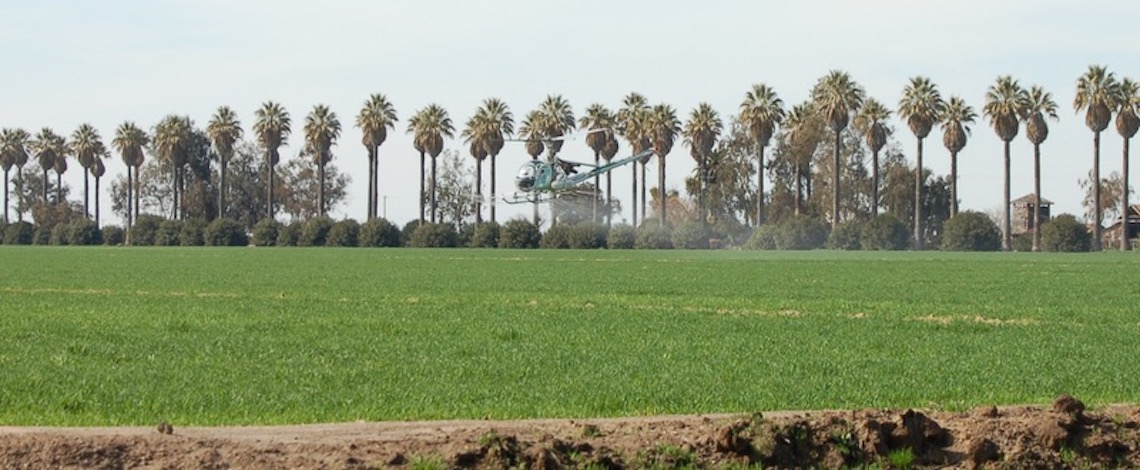
A helicopter applies chemicals in a field west of Fresno. 2017 file Photo
Written by Alex Scott
For decades the Central Valley has served as the agricultural hub of the world, supplying fruits, vegetables and nuts to countries as far as Japan and China.
According to the United States Geological Survey, using fewer than 1% of U.S. farmland, the Central Valley supplies 8% of U.S. agricultural output (by value) and produces a quarter of the nation’s food, including 40% of fruits, nuts and other table foods.
Since 1984, the valley has experienced substantial growth in accessible prime farmland.
According to the Field Office Technical Guides developed by the Natural Resources Conservation Service, prime farmland is land that has the best combination of physical and chemical characteristics for producing food, feed, forage, fiber and oilseed crops.
Based on a map of important farmland from the Department of Conservation, in 1984 rural parts of Fresno as well as towns like Reedley, Kerman, and Lemoore had substantial prime farmland for the time. In contrast, the Tulare and Visalia area did not have any prime farmland based on the map.
By 1990 the amount of prime farmland grew, filling in gaps in the South Valley toward Bakersfield and north toward Sacramento, extending into Chico.
As of the completed data collected in 2016, the amount of prime farmland extended toward the west near Los Banos and along the Interstate 5 corridor.
Looking at crops reports, however, there is a noticeable decline in harvested acreage for certain crops.
According to crop reports for Tulare County, the harvested acreage for field crops in 1984 was 1.39 million, whereas in 2021 it was 1.14 million. This dramatic loss of 243,500 acres is reflected in the other crop classifications as well and are as follows:
- — 5,787 harvested acreage loss for seed crops
- — 3,946 harvested acreage loss of vegetable crops
Despite losses in these areas, the county saw an increase in fruit and nut crops with a 200,319-acre gain, respectively.
Looking at Fresno County, a familiar phenomenon occurred from 2016 to 2021.
- — 4,950 harvested acre loss for seed crops
- — 38,463 harvested acre loss for vegetable crops
In contrast, Fresno County saw an increase in field crops and fruit and nut crops:
- — 85,160 harvested acre gain for field crops
- — 125,574 harvested acre gain for fruit and nut crops
Based on research done by Professor Serhat Asci, an associate professor at Fresno State teaching Agricultural Business Quantitative Methods and Management of Agri-food Supply Chains, these changes may be caused by farmers’ choices of what would produce the best yield and financial stability.
According to Asci, since 2000 there has been an increase in the production of almonds, walnuts and pistachios, with pistachios growing six times as 20 years ago. Likewise, there has been an increase in tangerine production at the same time as a small decline in grapes and peaches.
When it comes to water intensive crops such as grains and some vegetables, Asci observes that there has been a decline and hypothesizes this may be due to crop prices.
“When farmers see the crop prices are more stable in certain fruits or nuts, or if there is an increasing trend in crop prices, they are more willing to move into those crops,” said Asci.
Since cropland fluctuates, Asci’s observes that in several years’ time, certain nuts and fruits will no longer be preferable to farmers and that the upward trend in harvested acres may not last.
Dan Errotabere’s family farm has experienced this since his father first started in the 1920s. At first Errotabere’s father grew mostly roll crops such as cotton and alfalfa. Once Errotabere and his brothers took over the farm, they expanded into vegetables and eventually into tree crops.
“The landscape has changed considerably from those early days, moving from what can be a low value crop to much higher value crops; mainly because farming in California is expensive,” said Errotabere. “So, you have to seek out the highest value crops to increase sustainability the best you can.”
Recent trends show that the Sustainable Groundwater Management Act (SGMA) will become a major factor in land allocation decisions and cropland usage.
Under SMGA, farmers are restricted from using a set amount of water to care for their cropland. If the threshold is exceeded, the farmer is penalized for pumping more than what is considered a sustainable yield. As a result of the overdraft, they will be required to pay a fee per-acre foot of water pumped.
With these restrictions and an already low water supply, the valley will experience more fallowed fields and potentially more crop changes. This is a direct result of farmers having limited flexibility on what they can do with the fallowed land, no matter the price of the commodity because there is not enough excess water to farm the land.
“We aren’t necessarily losing cropland, we’re losing the ability to farm it,” said Errotabere. “We don’t have the volume in the productive base, supporting the overhead activities of the farm.”
At the same time, since California understands the limited and restricted resources the state has, the Central Valley has one of the smallest water footprints in the world. Unfortunately, if it shrinks too much there will be more financial hardship in the industry, especially for family farms.
“For family farms out here. the challenges are very real and very big. You have to wonder, in the next generation, who comes out and takes our place when you present it with all these things?” said Errotabere.








